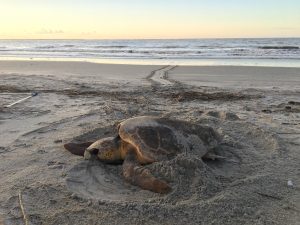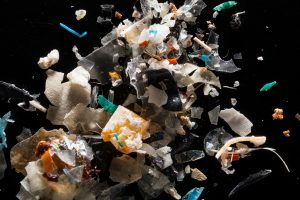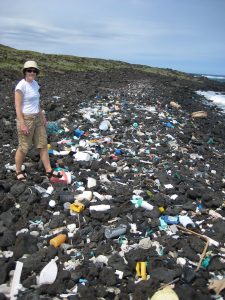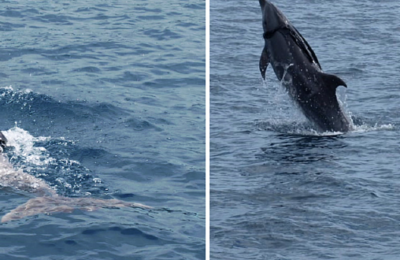It is the scourge of the ocean. Floating with the waves, soulless, emotionless, without motivation or destination, it chokes life from the sea wherever it goes. What could this horrible fiend be? It’s plastic, and steadily and surely, we are helping it take over the ocean.

Plastics can hurt sea life in a number of ways. You’ve probably seen images of birds, seals, or sea turtles trapped or killed by various plastics. Plastics bags, for example, are often eaten by turtles because the floating masses look like jellyfish, a staple food in the leatherback sea turtles’ diet. Filling their digestive tract with indigestible garbage, they eventually starve to death. Now, researchers wonder if microplastics pose a risk to sea turtles as well.
At this point, so much plastic has made its way to the ocean that there is a patch of floating plastic larger than the size of Texas, called the Great Pacific Garbage Patch. So why don’t we just clean it up? For one, plastics don’t stay in their original form. Floating plastics react to sunlight by degrading into smaller pieces, but not decomposing the way organic materials do. They just become smaller, tinier bits of plastic. Once the plastic particles get to a size that is less than 5mm long, they are called microplastics. These tiny plastic pieces are too small and numerous to simply haul out of the water.
Like plastic bags and other larger plastic pieces, these insidious micro particles can make their way into animal digestive tracts, especially plankton eating shellfish and the charismatic humpback whale, but they also can pollute the habitat animals are living in. This pollution is what concerns Doctors Beckwith and Fuentes, from Florida State University. If microplastics are spreading through the ocean, what does this mean for the future of sea turtles in their nesting grounds?

Plastic and Turtle Eggs
Loggerhead sea turtles are a vulnerable species that have important nesting grounds off of Florida in the Gulf of Mexico. To study the prevalence of microplastics in nesting grounds, the researchers chose ten nesting sites in the Northern Gulf of Mexico. They selected six sample sites at each of the 10 nesting grounds, where they collected the top layer of sand and brought it back to their lab. The microplastics were then separated from the sand in each sample using a salt solution; the density kept plastics floating at the surface while the sand settled. The plastics were then scooped out with a sieve, counted and weighed, then divided by color and shape.
The researchers found microplastics at each of the ten nesting sites, although there were more microplastics on Western nesting sites, likely due to the nature of the currents through the Gulf. They also noted that the majority of microplastics found (59.9%) were found in the sand dunes, the area of the beach where turtles prefer to nest. The rest of the microplastics were found at the point where high tide ended on the shoreline. The microplastics were primarily hard plastics, and mostly white and orange in color, although black and cream colored plastics were also abundant.
What the presence of microplastics at these nesting grounds means for sea turtles is still unclear. One of the primary concerns is that the presence of microplastics may change the temperature of the sand the eggs are laid in. The sex of turtles is not determined by genetics like in humans, but is actually determined by the temperature the eggs are kept at before the turtles hatch. Warmer temperatures mean that females hatch from the eggs. This is concerning considering in the Great Barrier Reef, warmer regions had sea turtle hatches that were skewed heavily towards females; 99.1% of the juvenile sea turtles found were female. Microplastics may keep sand warmer than it would be otherwise since they have a higher specific heat than the sand, only exacerbating the problem. The color of the microplastics could also dictate how they change the temperature of the sand; darker microplastics could absorb heat and warm the sand, while lighter particles could reflect sunlight and keep it cooler. Additionally, decaying plastics release chemicals that can alter estrogen in turtles, affecting their reproduction and possibly making the turtles less fertile. How much of a threat this poses to the species in general, however, is still uncertain.
What can we do?

While scientists still aren’t sure how these microplastics will impact sea turtles when they are nesting, we do know that the ubiquitous nature of plastic pollution means micoplastics are a threat all turtles face. Reducing our plastic use is the best way to combat this issue. While recycling plastic is important, it doesn’t make up for all the new plastic we make on a daily basis. Banning plastic straws may help ease some of the guilty feelings we get when we see a video of a poor sea turtle with a straw stuck up its nose, but it is such a tiny portion of the problem that the action is more symbolic than helpful. The spirit of the action, however, is in the right direction. Carry around a metal straw if you need one. Use a reusable water bottle. Use glass containers for your food instead of plastic (you’ll even be able to put them in the microwave). When you purchase food at the grocery store, opt for a glass can instead of plastic if you can, and bring reusable bags. Get your own travel coffee mug that you use in the morning. Avoid products, like hand sanitizer, with microbeads in them. More than all of these things, share what you’re doing with your friends and family. The steps are small, but together they can make a big difference in our plastic footprint, and in the lives of sea turtles.
I am a PhD student studying Biological Oceanography at the University of Rhode Island Graduate School of Oceanography. My interests are in food webs, ecology, and the interaction of humans and the ocean, whether that is in the form of fishing, pollution, climate change, or simply how we view the ocean. I am currently researching the decline of cancer crabs and lobsters in the Narragansett Bay.




Horrible that we are doing so much harm to the sea animals. Plastic is everywhere. It’s very hard to avoid contributing to this mess for all our groceries and clothing come in plastic. Frustrating!